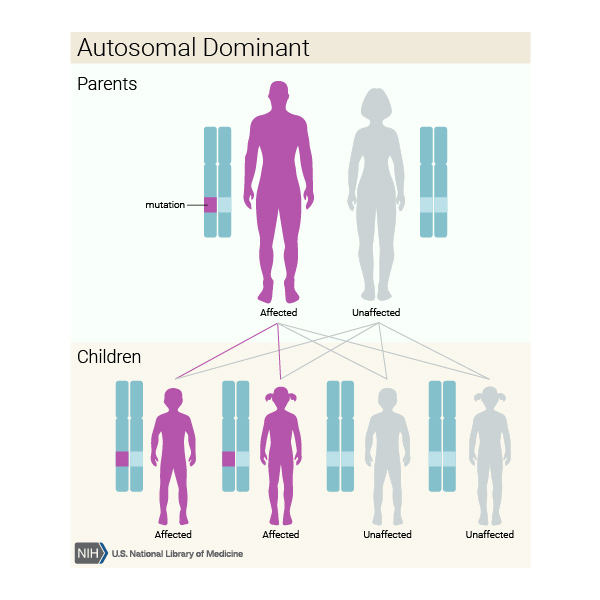Ataxias can occur due to a multitude of reasons. One way a patient might acquire ataxia is from an accident or an injury – not as a result of genetics. On the other hand, a patient could also inherit a specific mutation (a genetic defect, in other words) from one or both of their parents. In this case, the ataxia is called “hereditary.” Hereditary ataxias can be further classified as either “dominant” or “recessive.”
What is a dominantly-inherited disorder?
Most genes in our body have two copies: one that we inherit from our mother, and one that we inherit from our father. Dominantly-inherited disorders are diseases in which a mutation in just one copy of a gene is enough to cause disease. When both copies of a gene need to be mutated to cause symptoms, the disorder is known as “recessive” (learn more in the Snapshot on recessive ataxias). For a patient with a dominantly-inherited ataxia, this means that there is a 1-in-2 chance that their children will inherit the disease-causing mutation (assuming that their spouse is unaffected). If both spouses are affected by the same dominantly-inherited disease, this chance increases to 3-in-4. In cases where the child inherits both mutant copies of the gene, the symptoms are often more severe than when a single copy is inherited.
Which ataxias are dominantly-inherited?The most well-known ataxias with dominant inheritance patterns are the Spinocerebellar Ataxias (SCAs), such as SCA1, SCA2, SCA3, SCA6, and SCA7. Each disease is caused by defects in a different gene. Due to the high similarity in symptoms among all ataxias, genetic testing is often required to determine the exact gene mutation and type of ataxia a patient has.

How can a patient prevent passing on a dominantly-inherited disorder to their children?
There are multiple options to prevent passing on the disease to your child if you are affected by a hereditary ataxia. One potential option is to perform in vitro fertilization (IVF), a technology that is used the conceive embryos outside the human body. The embryos can be screened for genetic mutations, allowing only the healthy embryos to be implanted into the uterus.
If you are affected by a hereditary ataxia and want to prevent having a child with ataxia, it is recommended to talk to your physician and genetic counselor regarding reproductive options.
If you would like to learn more about in vitro fertilization and embryo screening, please take a look at these resources by the University of Pennsylvania. If you want to learn more about dominant ataxia, take a look at these resources by the National Organization for Rare Disorders and Ataxia Canada.
Snapshot written by Larissa Nitschke and edited by Dr. Marija Cvetanovic.









